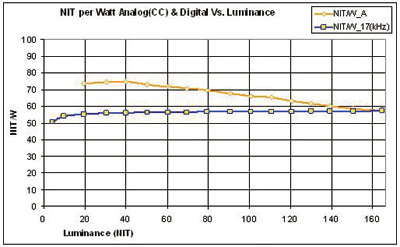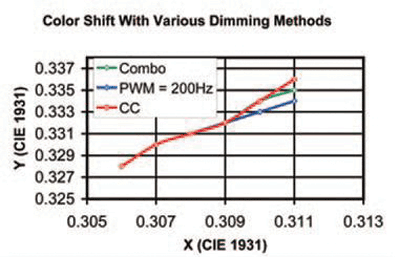Improving color quality in displays that use white LEDs
Careful selection of dimming techniques, combined with latest color management technology, yields superior results
BY BRUCE FERGUSON and MICHAEL TRAN
Microsemi, Irvine, CA
http://www.microsemi.com
As the use of white LEDs extends beyond portable displays into much larger screen sizes, system designers have had to perfect solutions to problems associated with color shift. Dimming is a key contributor to the problem.
Traditionally, dimming-related color shift has been resolved by using pulse width modulation (PWM) dimming that, unfortunately, also exact a penalty in efficiency. However, when PWM is used only at lower brightness levels and a variable constant-current (CC) dimming technique is used at higher LED current levels, white LEDs can be driven much more efficiently while minimizing color shift. A secondary benefit is longer battery life for portable devices, plus “greener” and more cost-efficient operation across a wide range of display types.
CC dimming
CC dimming is a commonly used approach. Because display brightness is directly proportional to the LED forward current, it can be increased or decreased simply by either raising or lowering this current.
The problem with this CC dimming approach, however, is that it can cause a color shift that varies with the value of the LED current. Even when the shift is minimal, as is usually the case, the human eye still can often detect a yellow shift in a dim display or blue shift in a bright display.
These shifts are byproducts of how LEDs are constructed by taking an InGaN blue LED chip (which emits blue light) with a yellow phosphor (or YAG, which emits yellow light) and creating the familiar “lunar-white” effect. When the display is dimmed by decreasing the white LED’s forward current, the dominant blue wavelength of the InGaN chip and relative intensity of the YAG both increase, resulting in the shift to yellow.
PWM dimming
LED manufacturers often recommend PWM over CC dimming. Indeed, PWM dimming is completely satisfactory as long as the white LED temperature remains low. PWM works by driving the LED with a pulsed current in either a fully-on or fully-off state.
Maximum display brightness is achieved at a 100% pulse duty cycle. The LED’s average current is the product of the duty cycle and the full-scale current. At any duty cycle, the instantaneous amplitude of the current “on time” pulse is always the full-scale current.
By varying the pulse duty cycle from 0% (off) to 100% (full-scale), designers can program a full range of brightness. The display only “appears” dimmed because the pulse frequency is set above 100 Hz and the human eye then averages the brightness of the pulsed display. Further, because the pulses occur with only full-scale amplitude, there is no change in forward current, as with CC dimming, and therefore theoretically no color shift.
Despite how well PWM works at full-scale current to reduce color shift, a more thorough analysis of application requirements is always necessary before selecting only this approach. PWM dimming performs well as long as the white LED temperature remains low, which is not always the case.
Further, color shift associated with temperature variation from localized white LED self-heating can often be greater than color shift associated with forward current variation at constant temperature. Plus, it can require cost-prohibitive modifications to the backlight assembly in order to create a more effective heat sink that will ensure constant low temperature operation for the white LED. In some cases, the optimal solution may not be PWM, but rather CC dimming or a combination of CC at higher currents with PWM at lower currents.
Efficiency
Another key consideration is efficiency (defined as display efficiency and its effect on battery life), which is typically measured at one-third the maximum display brightness. PWM dimming is simply not as efficient as CC, as shown in Fig. 1 . This is especially true at lower currents, since the relative efficacy of white LEDs decreases as current rises.

Fig. 1. As shown in the above efficiency vs dimming method graph, PWM dimming is simply not as efficient as CC.
In contrast, PWM always maintains full-scale LED pulse current, so it must operate at lower-than-optimal current at lower duty cycles as compared to variable CC-dimmed LED displays at the same brightness levels. Also, because PWM operates at a higher current, it dissipates more overall power, since the white LED has a higher forward voltage.
Specifically, the forward voltage at 30 mA is 10% higher than the forward voltage at 10 mA (see Fig. 2 ). As a result, a 30-mA full-scale current at 33% PWM duty cycle will consume more power as measured in V x I_average than a 10-mA CC dimming solution. Together, these two factors increase losses in PWM efficacy.

Fig. 2. Because PWM operates at a higher current, it dissipates more overall power, since the white LED has a higher forward voltage.
Implementing an optimal combination of CC and PWM dimming for higher and lower currents, respectively, has been simplified with the advent of LED drivers that feature separate control inputs for setting the PWM pulse current and duty cycle. Figure 3 illustrates this approach using the Microsemi LX1996 LED driver. In this example, the analog control voltage is proportional to the LED on-current.
The voltage is provided to the DI input, and the PWM duty cycle control is applied to the PWM input. As an example, the Microsemi LX1972 light sensor provides input to the LX1800 multiplying DAC to enable ambient light correction for the display.

Fig. 3. LX1996 LED driver provides the necessary separate control inputs for a combination of CC and PWM dimming.
One approach to combination dimming is to use PWM for LEDs operating at less than 50 percent full-scale, and CC for LEDs operating in a range from 50% to 100% full-scale. Figure 4 shows the reduction in color shift that results from using this particular combination of dimming approaches as compared to CC only.

Fig. 4. The choice of PWM, CC and combined PWM and CC dimming yields differences in LCD white flat field color shift.
Further color quality improvements are possible using the latest color-management technology for RGB LED backlighting of LCD displays. By implementing a companion color-management MCU to operate alongside the LED driver, it is possible to provide fast, precise closed-loop color control to stabilize user-selected brightness and color points over various environmental conditions such as temperature variations and the aging effects of LEDs.
This approach addresses the inherent color accuracy issues associated with generic LED backlights, and applies a system-level strategy to addressing the entire color management loop. It enables users to adjust the white point of the backlight using a simple graphical user interface, with virtually instantaneous response and an accurate color palate as the color loop controller compensates for any changes in color point settings within milliseconds.
The LCD backlighting industry continues to make significant strides toward reducing color shift and improving overall color quality when using LED light sources for portable and larger displays. The decision regarding which dimming method to use in LCDs featuring white LED backlights requires careful consideration.
To ensure optimal display efficiency for portable and fixed applications, a variable CC method is generally the best option, especially for displays operating at midrange brightness levels. When temperature effects are a key concern, it may matter less which dimming method is employed.
In situations where CC dimming is insufficient for controlling color shift, display designers can minimize color shift while improving efficacy by employing CC at the brightest display levels and PWM at the dimmer levels, while also setting the PWM “on current” to from 33% to 50% of the full-scale current. Finally, designers also should consider the latest color management technologies that provide users with an even greater real-time control over color quality. ■
Advertisement
Learn more about Microsemi





